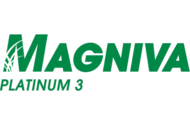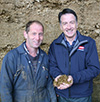
Andrew Quick
Beef producer
“In trials, wholecrop silage was ensiled with either no inoculant or with MAGNIVA Platinum. The MAGNIVA inoculant kept the silage much cooler for the whole period, meaning more energy would be available to feed.”
Name: Bury Barton Farm
Location: Lapford, UK
Size: 100 mainly Limousin suckler cows
Inoculant: MAGNIVA Platinum
Producing and utilising high-quality silage is central to success for a beef unit in mid-Devon. Andrew Quick and his son Edward farm 400 acres at Bury Barton Farm, Lapford, which is home to 100 mainly Limousin suckler cows split into spring and autumn calving groups and 500 ewes. Mainly down to grass, they also grow 60 acres of spring barley for wholecrop, 30 acres of forage maize and 70-80 acres of cereals. They finish all the suckler calves, which are weaned at 8 months and will finish at 16-18 months. They also buy in mainly British Blue and Limousin steers and a few heifers at around five months old. In total, they finish around 250 cattle per year. Home-bred animals and bought-in steers are targeted at a 370kg carcase, while bought-in heifers go at around 330kg carcass weight. Quality silage is at the heart of the system. The Quicks make fermented wholecrop cereals, maize and grass silage, which form the basis of growing and finishing rations that which typically comprise one third of each forage. First cut grass is taken in late May with a second cut in mid-June. Second cut is used for the suckler cows and is allowed to become more stemmy. “Silage is a big investment for us so we focus on making the best quality we can and also on reducing waste,” Andrew explains. “The more high-quality forage we can feed, the lower our overall costs. Silage waste just pushes up costs because all the investment in making silage is related to the feed we put in the clamps, not what we feed out. So, we do all we can to waste as little as possible.” Andrew targets making all forages at above 30% dry matter. Growing cattle are fed 17-18kg of mixed silages per day while the finishers will get 20kg/day. Both groups are also fed home grown wheat, but Andrew doesn’t feed any purchased protein as there is enough in the grass silage. “One of our priorities when making silages, particularly wholecrop and maize, is achieving good aerobic stability,” Andrew continues. “We feed out once a day, so we need the forages to keep cool and fresh to ensure we achieve high intakes. “We also need the clamps to stay cool in the summer when we are using less as we have more cattle out at grass, which means we go across the clamp slower. A face exposed for a long time in heat could lead to increased problems with heating, which reduces intakes and feed value as heat is just energy being burnt up.” To help minimise waste and aerobic spoilage, Andrew has been working with Steve Symons from Lallemand Animal Nutrition and in 2019 used MAGNIVA inoculants on the wholecrop and maize. “There are two key objectives when making silage, whatever the crop,” Mr Symons comments. “The first is to achieve a rapid initial fermentation and pH drop while the second is to keep the crop stable once it is opened. “Magniva Platinum crop and condition specific forage inoculants, which supersede the Biotal range, combine the proven strain L buchneri 40788 with the totally new patented bacterium L Hilgardii I-4785. They deliver the rapid initial fermentation and then quickly produce a number of antifungal compounds to knock back the yeasts and moulds responsible for heating, improving immediate aerobic stability, meaning clamps can be opened sooner. They also improve longer term aerobic stability, protecting the silage while the clamp is open. “In trials wholecrop silage was ensiled with either no inoculant or with Magniva Platinum Wholecrop. The Magniva inoculant kept the silage much cooler for the whole period, meaning more energy would be available to feed. “With margins continuing to be squeezed, focusing on maximising the use of high-quality forage will be crucial for beef producers,” he concludes.
Fabio Corleoni
Beef producer
“With MAGNIVA the animals are healthy, with excellent feed intake and conversion.”
Name: Fabio Corleoni
Location: Italy
Size: 200 bulls and calves for white meat production
Inoculant: MAGNIVA
In 2021, Mr. Fabio Corleoni, a beef producer from Brescia, made a decision that significantly altered the course of his silage process. He incorporated MAGNIVA inoculants into his silage routine, a move that has since led to significant improvements in the quality and preservation of the silage. “The application of Magniva was simple and hassle-free,” says Mr. Fabio, who adhered to the recommended dosages on the package, applying the inoculum directly with a forage harvester. “The application process was characterized by its simplicity, requiring minimal preparation and no disposal of materials,” Fabio explained. Thanks to the use of Magniva, Fabio always obtains high-quality silage. From the initial opening of the silo to the last feed, Mr. Fabio observed high-quality silage, with no waste. Mr. Fabio observed that “MAGNIVA ensured a constant fermentation that became a standard event and the silage maintained its stability throughout the feed distribution process. In addition, the animals are healthy, with excellent feed intake and conversion.” The improved silage quality extended beyond the stability of the bunker. Magniva also helped make the TMR feed more palatable and stable at the feed trough, eliminating previous concerns about the heterogeneity of the TMR. Bunker management was also simplified, making silage removal a very simple task. Mr. Fabio observed that “I no longer had to remove areas of spoiled silage on the hat or corners of the trench, which not only took a lot of time but also resulted in silage losses. Silage treated with Magniva has no silage losses.” Fabio’s positive experience with Magniva led him to recommend the product, arguing that the combination of these inoculants with good management practices is essential for achieving profitability and success. Trying Magniva could be the breakthrough you need, allowing you to administer high-quality silage and increase the profitability of your business.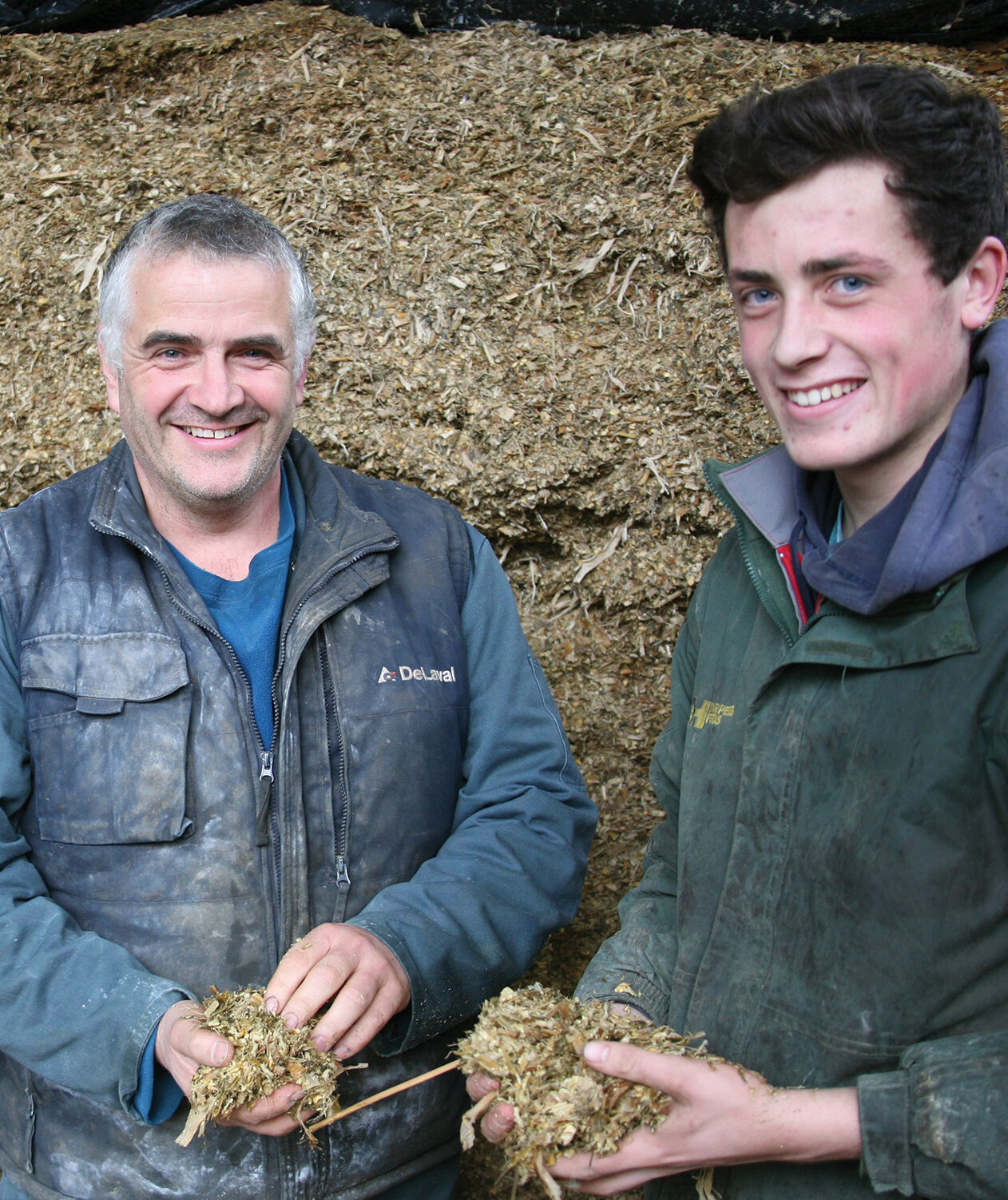
Jack Daniel
Dairy producer
“Our focus is on making the best quality silages we can as the basis for the ration. We also want to ensure that we feed as much as possible of the crop that goes into the clamp. MAGNIVA is keeping the clamp really cool, ensuring more of the energy gets into the cows.”
Name: Daniel family, Lower Rillaton Farm
Location: Callington in Cornwall, UK
Size: 160 dairy cows
Inoculant: MAGNIVA Platinum
Inoculants help drive forage efficiency
When your system is geared to turning home produced feeds into milk, forage efficiency is a key business objective. For the Daniel family from Lower Rillaton Farm, near Callington in Cornwall, ensuring effective fermentation and good stability is the foundation of their silage making. Jack Daniel runs the 350 acre farm with his father, Chris, and his sons, Matthew and Alex. The farm is home to 160 year-round calving cows averaging 8000 litres at 4.68% fat and 3.69% protein and the cropping is geared to feeding the stock on the farm. The cows are housed at night all year and graze by day in the summer. In addition to 230 acres of a mix of permanent pasture and grass reseeds, there are 30 acres of maize, 30 acres of wheat and 60 acres of barley, which is fed with a 25% double-mineralised protein concentrate. Diets are developed with Matt Dymond from Harpers Feeds and the cows are currently on 25kg grass silage, 10kg maize silage, 2.5kg treated wheat, 2kg of a soya/rape blend, straw, minerals and 5kg of bought-in fodder beet. This TMR gives M+16 litres with the barley/protein mix fed to yield through the parlour.Waste pushes up costs
“Our focus is on making the best quality silages we can as the basis for the ration,” Jack explains. “We also want to ensure that we feed as much as possible of the crop that goes into the clamp. Waste is just a drain on the business, pushing up costs.” Around 140 acres of first cut were taken in mid-May as they like a bit more fibre in first cut. Second cut of 110 acres was taken in late June with third and fourth cuts being baled. The family cut and rake the grass, before a contractor chops and clamps it. Chris Daniel rolls the clamp alongside the buck rake as they want good consolidation. First cut analysed at 27% DM and 11.8MJ ME/kg DM while second cut came in at 32% DM and 11.1MJ ME/kg DM. “Feeding grass all year round, we are after a rapid fermentation and a stable product as it takes us a week to get across the face in the summer and the clamps are outdoors and exposed to the elements.” This year they will move to the new MAGNIVA range of inoculants for grass Maize has been a central part of the system for many years and was drilled in mid-April under plastic. It was harvested in early October and treated with the new MAGNIVA Platinum inoculant.Less heating
MAGNIVA Platinum contains a unique combination of bacteria, L. buchneri and L. hilgardii, which quickly produce a number of antifungal compounds that significantly reduce the yeasts and moulds that cause heating, improving immediate aerobic stability, meaning clamps can be opened safely much sooner. They also improve longer term aerobic stability, protecting the silage while the clamp is open. By significantly reducing the populations of both yeasts and moulds, the antifungal compounds produced by the MAGNIVA inoculants reduce the main cause of the clamp heating and energy loss as well as reduced silage palatability. “Stability is really important for us,” Jack continues. “It takes us 4-5 days to work across the face and we don’t want to see the silage heating as this is just wasting energy and increasing our costs. We had concerns this year as we had a wet September and there were signs of Fusarium, which might have caused the clamp to heat up.” Steve Symons from Lallemand Animal Nutrition recently took infrared photographs of the clamp, and they show no signs of heating across the face. “MAGNIVA is keeping the clamp really cool, ensuring more of the energy gets into the cows. Temperature readings taken show the temperature eight inches behind the face was also consistent, a sure sign of excellent aerobic stability.”
Joe Carter
Dairy producer
“I believe you get from the cows what you put in, and performance almost always relates back to forage quality”
Name: Joe Carter
Location: Chippenham, Wiltshire, UK
Size: 300 Holsteins
Inoculant: MAGNIVA Platinum
Joe Carter has used the Opticut silage cutting system in combination with Magniva forage inoculants to help improve his forage quality. Following a move to earlier and more frequent silage cuts, dairy farmer Joe Carter, has improved forage quality which has helped reduce his purchased feed costs. Since changing to an Opticut silaging system three years ago, which is tailored to each farm and governed by pre-cut grass testing, the grass silage’s average metabolisable energy (ME) has increased from 10.5 to 11.5 MJ/kgDM with much greater consistency across all cuts, and from year to year.Current averages: • 10,939 litres per lactation, with 2,877 litres of that from forage this year’s target is to further increase milk from forage by 1,000 litres • Calving interval is 384 days • Herd has a pregnancy rate of 24.3% • Daily lifetime yield is 20.4 litres, placing him in the top 5% of British producersCow health, fertility and welfare are the priorities, achieved through genetics, high quality feed and cow comfort, with the aim that high milk production will follow. • The milking cows average about 35 litres a day, with a milk quality of just over 4.0% butterfat and 3.25% protein on twice a day milking. “I believe you get from the cows what you put in, and performance almost always relates back to forage quality” Mr Carter says.How to reduce purchased feed
“Since adopting the Opticut approach purchased feeds have been reduced purchased feeds have been reduced by 0.5kg on average, from around 11kg to 10.5kg/cow/day,” explains Mr Carter. “We feed just one total mixed ration (TMR) to the milkers to keep it as simple as possible and avoid any potential issues from diet changes. We realise this reduces our overall production from forage, so to achieve our target of increasing production from forage we have to make higher quality, digestible and palatable silages to enable us to challenge the cows, especially those in early lactation, and reduce our reliance on purchased feeds.”Cropping policy
All of the land is used to grow grass and maize, they operate a five-year cropping plan, with three-year grass leys and two years of maize. It means 50 acres of new, medium term grass leys are planted every year. “This system helps to increase grass quality and ensure consistent heading dates,” Mr Carter explains. “We began to change our cropping and silaging system about 11 years ago when we started working with our nutritionist Roy Eastlake. Our long-term goal has been to improve financial margins by producing a higher energy forage so that we can reduce purchased feed costs.”Grass cutting dates and pre-cut grass testing
Five years ago the Carters stopped grazing their cows which allowed them to move from a traditional three-cut silage system towards cutting earlier and more often. To enable this, they began pre-cut grass testing. The first year was an eyeopener as they saw how the ME dipped with each test. “We saw that we should have cut two or three weeks earlier and that gave us the confidence to rely on the sample data in future,” says Mr Carter. They fully moved to an Opticut system three years ago, basing every timing decision on grass sample results. Their aim is to take first cut as early as possible and then every four or five weeks after that, up to a total of five or six cuts. Pre-cut testing carries on throughout the season, with Roy ensuring it is done regularly. “For anyone thinking of trying this type of system, I’d say start with regular pre-cut grass testing and let the data convince you,” Mr Carter says.Silage team planning meetings
“Weather is also a big factor, so we don’t always achieve the optimum cut timings,” says Mr Carter. “We sit down in January or February with our agronomist, silage contractor and nutritionist, to review the previous year and make a plan for what we want to achieve.” The agronomist produces the fertiliser plan and contractors apply it as soon as it is dry enough, with flotation tyres enabling them to travel earlier. Slurry and dirty water are also utilised alongside the bagged fertiliser after each cut. “As cow numbers have grown and we’ve upped the amount of forage being fed to each cow, it means we need more forage. So in the future, we plan to grow more grass at home and contract grow maize away from the farm, hopefully with a local arable farmer. “This will enable us to grow and take control of all our forage needs and build up a bank of forage to cover our requirements in poorer yielding years,” he said.Using an Magniva forage inoculants
An inoculant is used to aid preservation and retain nutritional value, either Magniva Platinum Grass Dry or Magniva Classic, depending on dry matter levels when grass is picked up.Managing the silage clamp to optimise forage quality
When sheeting up, they use an oxygen barrier film, along with extra-large side sheets that meet in the middle over the oxygen barrier. This completely seals the clamp at the edges and weighted nets are used on top. As a result of this attention to detail, silage quality and palatability is increased so there is a lot less wastage and fewer refusals at feed out. “The silage keeps better,” says Mr Carter. “We overfeed milking cows by about 5% and then clean up what they don’t eat to feed to the heifers. By that point, it’s been out for up to three days and is still palatable. The ensiling process and specific inoculant is vital to ensuring a stable silage at feedout.” However, as a consequence of growing higher quality forage for the milking cows, they also need to purchase chopped straw to provide some effective fibre and lower energy forage for feeding to the dry cows and heifer replacements. “As straw is now very expensive and storing chopped straw is difficult on the farm, we’re exploring growing a palatable but lower energy grass silage. “We aim to achieve this by letting the whole or part of one of the cuts mature more and then harvesting this as a straw replacer. This could then be taken as either big bales, stored in a separate clamp or even a segment down the length of one of the main clamps.”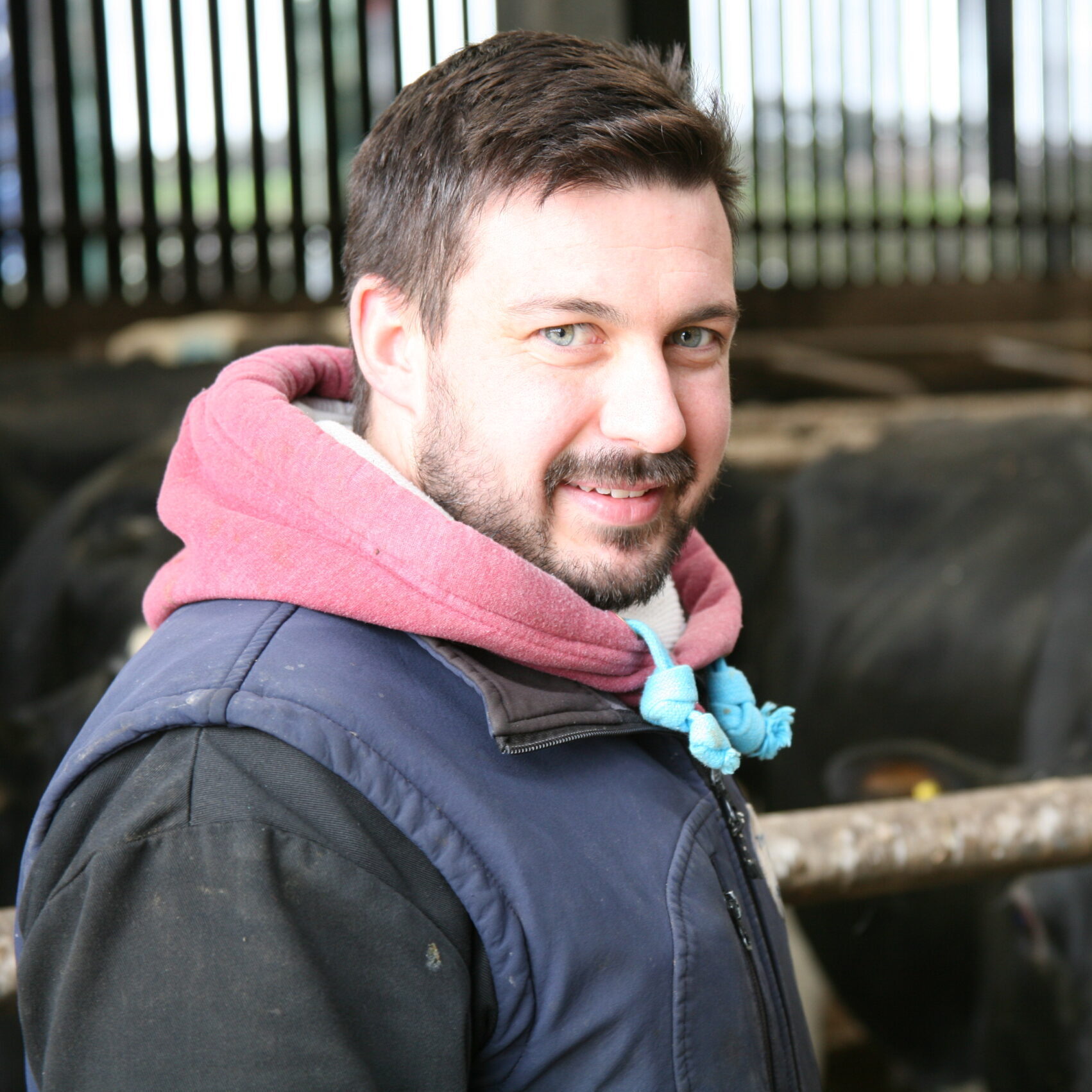
Joseph Andrews
Dairy producer
“We now have a system which works for dry cows, meaning cows are calving down well. We are on target to get heifers coming in at the start of the block, which will help keep it tight.”
Name: Joseph Andrew farms at Silkland Farm
Location: Buckland Brewer, UK
Size: 350 Holstein cows
Inoculant: MAGNIVA Platinum
Four years ago, a Devon business made the decision to move to autumn calving and continues to refine their system with an emphasis on quality forage.
Learning to live with autumn calving
Joseph Andrew farms at Silkland Farm, Buckland Brewer with his father Steve and brother Jack. They farm a total of 220 hectares which is mainly down to grass, but they also grow 40 hectares of maize and 12 hectares of spring barley for wholecrop. The farm is home to a herd of 350 Holstein cows which until four years ago were all year-round calving, but now calve in an autumn block, starting at the beginning of August and all cows will calve by the end of December. “We are in a good grass growing area and wanted to focus on maximising the contribution from forage to help reduce purchased feed use,” Joseph explains. “We felt autumn calving would be the best way to achieve this and are pleased with the move, but we are learning all the time. “In particular, we initially thought cows would graze more and this would be the way we would see the biggest benefits. But we are moving away from this thought this year.” The herd is averaging 9000 litres at 4.3% fat and 3.4% protein. Milk quality is important as milk is sold to Saputo Dairy UK on a cheese contract. They rear all their own heifers looking to calve them in at the start of the block. Heifers are served at 12 months and when they have sufficient stature. They have built a new calf shed to help improve health and growth rates and will look to have 100 heifers available to bring into the herd. At the latest PD session, 80 heifers were seen by the vet and 78 were in calf. All cows and heifers will be served twice to sexed semen before being put to beef. Cows are housed as soon as a group of 50 has calved in, justifying opening up the housing and giving a large enough group for feeding. As 100 cows and heifers will calve in August, fresh calved cows are effectively housed from mid-August. All cows are housed in one group and fed a single TMR which comprises maize silage, grass silage, wholecrop cereals and a rape:soya blend supplied by Harpers Feeds. The TMR is formulated for M+20 litres and the aim is to feed a consistent diet throughout the winter, only tweaking it when clamps are changed. An 18% Harpers dairy compound is fed to yield through out of parlour feeders. At peak, cows were averaging 34 litres per day and now are producing 33 litres with an average of 180 days in milk. Consistency of forage supply and quality is key to the system. The Andrews want enough maize to feed right through until turnout and for buffer feed. They will close the clamp up as cows dry off to ensure they have silage to feed as cows are housed in August and before the current year crop has been harvested. The drive for forage quality is being extended to grass silage too. “In previous years we had turned cows out as soon as we could but this reduced the amount of first cut we can make. So this year they will be housed until after first cut, allowing us to make 90 hectares of first cut,” Joseph explains. “To make the best use of forage we need the highest quality first and subsequent cuts to get cows milking and keep them performing. The cows are milking well on the winter diet and there is no reason this won’t continue, so we are happy to keep them in leaving more grass for first cut. If we have more first cut, we can get better performance in the first 150 days of lactation next winter. “As the majority of grass is young leys on a five-year rotation, making more first cut will mean we have a higher protein feed which should help keep feed costs down.” The aim will be to definitely make four cuts and possibly five if the first cut comes off soon enough. Around 60 hectares will be taken for second and subsequent cuts. Maize is grown on a 40-hectare block away from the farm so is grown continuously. The field received slurry and the manure from the 28,000 broiler unit. They grow an early variety as they want the crop off quickly, so it is in the clamp and ready to feed. They mainly grow the LG variety Ambition as it grows consistently well, although they have also used LG Pinnacle. They are looking to make 1800-2000 tonnes per year. In addition, they will buy in 500 tonnes from a neighbouring farmer. This year Joseph is considering undersowing the maize to help prevent soil erosion as stubbles are left overwinter. If conditions allow it can then be taken as an early first cut or just ploughed in. They grow spring barley for wholecrop. In total they will grow 24 hectares with half grown on a local farm. They prefer spring barley because it is simpler and less expensive to grow than winter crops. Also, having been in the ground for a shorter time it will be harvested greener and with less lignin. They look to harvest at 40%DM. While starch will be 26-28% compared to winter wheat at over 30% starch, they believe the other benefits outweigh the lower starch, especially as they can feed plenty of maize. Wholecrop plays a key role in dry cow feeding. Close up dry cows are housed a month before calving and go onto a diet based on wholecrop. “We used to feed a straw-based DCAB diet but thought if we could feed straw, we could use wholecrop. We now feed 80% wholecrop and 20% of the milking cow buffer or TMR. We also feed dry cow rolls and have very few calving problems.” The Andrews pay particular attention to clamping of crops as they do not have a series of silage pits but rely on some earth walled clamps with other cuts being built into clamps on a concrete pad. “Having focussed on producing high yields and cutting crops at the optimum stage, we can not afford to waste silage,” Joseph points out. “Our system is geared towards utilising as much forage as we can, so we pay close attention to ensiling to reduce the risk of waste.” Joseph takes responsibility for building all the clamps, buck raking and rolling to achieve a high standard of consolidation. All clamps are sealed with an oxygen barrier, a sheet of black plastic, two heavy woven sheets and as many tyres as possible. All crops are treated with Lallemand Animal Nutrition’s heterofermentative inoculants as aerobic stability is vital. They had tried homofermentative inoculants but were disappointed with the results so now use heterofermentative products. “We have often had to open wholecrop and maize clamps sooner than we would like so want them to be as stable as possible to reduce spoilage and heating,” Joseph continues. “Then we don’t want the clamp face to spoil as we feed out while can be a practical challenge. For example, our current maize face is over 20 feet high and it is taking us 10 days to get across the face, so heating is a real concern.” They had previously used Lallemand Animal Nutrition’s Biotal Wholecrop Gold and Biotal Maizecool to increase stability, but this year changed to Magniva Platinum Wholecrop and Magniva Platinum Maize. Steve Symons from Lallemand Animal Nutrition explains that the mode of action of heterofermentative bacteria specifically helps improve aerobic stability. “To improve aerobic stability and reduce heating you need to restrict the action of yeast and moulds present on all silages. Homofermentative inoculants have no positive effect against yeasts and moulds. As they produce lactic acid which is a food source for yeasts and moulds, they can increase the populations. Heterofermentative strains will improve stability by killing yeast and moulds while also ensuring an effective initial fermentation. “L buchneri NCIMB 40788 has long been the gold standard for aerobic stability but when paired with L hilgardii CNCM I-4785 in Magniva Platinum inoculants the two work in synergy. During the fermentation they quickly produce a number of antifungal compounds that significantly reduce the yeasts and moulds that cause heating, improving immediate aerobic stability, meaning clamps can be opened safely much sooner. “In trials both maize and wholecrop can be opened and remain aerobically stable just 15 days after harvest, increasing feeding flexibility. They also improve longer term aerobic stability, protecting the silage while the clamp is open. “Despite having to open wholecrop soon after harvest and work with a large maize face, Joseph has had virtually no waste allowing him to maximise the silage fed. We will be moving to Magniva Platinum inoculants on all grass cuts this year too.” Joseph Andrew concedes they are still learning about how to get the best from an autumn block-calving herd but is confident they are heading in the right direction. “We now have a system which works for dry cows, meaning cows are calving down well. We are on target to get heifers coming in at the start of the block which will help keep it tight. “We have refined our forage production to ensure cows remain on a consistent diet throughout the winter and have learnt that early turnout is not necessarily a pre-requisite for autumn calving. Maximising production from forage is about year-round quality and maximising the amount available to feed. At the same time, using the right inoculant means we can open clamps early if we need to. “We will continue to fine-tune the system to reduce cost of production and drive the use of quality forage,” he concludes.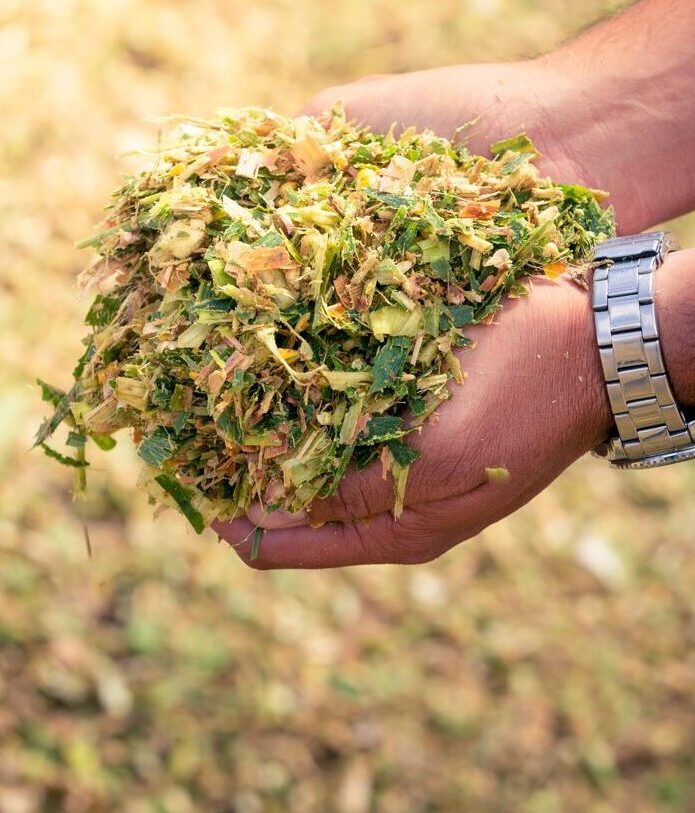
Justin Cunfer, DVM
Veterinarian and beef producer
“We have noticed that the cattle seem happier and eat better since we started using MAGNVA Titanium.”
Name: Justin Cunfer, DVM
Location: Lehighton, Pennsylvania, USA
Size: 30 breeding animals and between 50 to 60 feedlot steers
Inoculant: MAGNIVA Titanium
Justin Cunfer, DVM, raises Black Angus cattle while simultaneously operating Cunfer Veterinary Services in Lehighton, Pa. In both roles, he relies on products that support animal well-being and economic returns. Dr. Cunfer and his wife, Katie, operate the Never Done Farm where most of the beef is sold through custom orders. Together, they care for 30 breeding animals and between 50 to 60 feedlot steers. The operation relies on a plentiful supply of nutritious corn silage and baleage. Producing high-quality feedstuffs helps maintain cattle productivity and support overall herd health and reproduction. Recently, Dr. Cunfer made the switch from granular forage inoculants to a water-soluble concentrate. In his experience, the granular product did not apply evenly, and mold was still visible after ensiling. Mold was a no-go for Dr. Cunfer, who knows that spoiled silage can result in reduced feed intake and decreased production. When fed unpalatable silage, cattle will not eat as much and what they do eat will be lower in important nutrients and potentially contaminated with undesirable microbes. In fact, a Kansas State University study in beef cattle showed including even 5.4% spoiled silage (as part of a 90% silage ration) had negative effects on nutrient digestibility, and the integrity of the forage mat in the rumen was destroyed. That’s why Dr. Cunfer turned to MAGNIVA Titanium, a research-proven forage inoculant containing Pediococcus pentosaceus NCIMB 12455 and the high dose rate Lactobacillus buchneri NCIMB 40788. It is the only silage inoculant reviewed by the US Food and Drug Administration (FDA) to allow claims for improved aerobic stability — providing maximum feedout stability and minimum spoilage. The inoculant helps achieve a fast initial fermentation and get the silage to a low, stable pH; aerobic organisms are then stifled and can no longer use valuable nutrients. Plus, anaerobic bacteria like clostridia and enterobacteria are overwhelmed. It’s a difference Dr. Cunfer can see when he pulls down silage every morning for feeding. “MAGNIVA Titanium has shown better overall feed value for our operation,” Dr. Cunfer says. “We have noticed that the cattle seem happier and eat better since we started using MAGNVA Titanium.”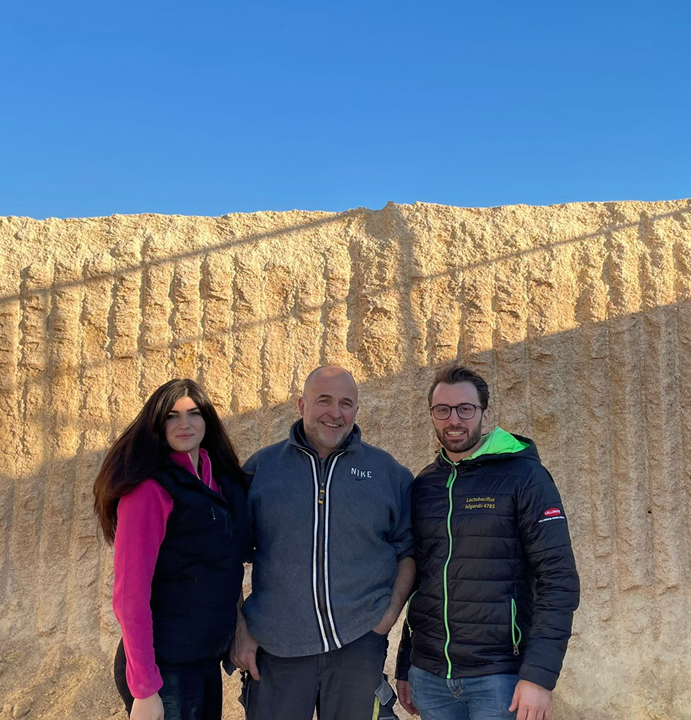
Mauro Gambaretto
Pig producer
“MAGNIVA Platinum 2 is very easy to apply and does not take much time. I just add it during the milling phase and then pack the silo tightly. I can open the silo after 17 days and find a high-quality product that is stable, fragrant, and bright“.
Name: Mauro Gambaretto
Location: Rodigo (Mantova), Italy
Size: 6500 fattening pigs
Inoculant: MAGNIVA Platinum 2
Mauro produces 3.700 tones of high moisture corn (HMC) every year to feed. “HMC is a valuable and nutritious feed, but it also requires careful management to avoid spoilage and toxins” He explains, “in fact for me toxins are my primary concern. I want my animals to be fed a healthy and wholesome silage, I think it’s fundamental. That’s why I use MAGNIVA Platinum 2, an inoculant from Lallemand that ensures a fast and efficient fermentation and reduces yeast and mold growth”. Mauro has been using Lallemand inoculants since 2004, now using new silage technologies such as MAGNIVA Platinum 2 Mauro is convinced of its ability to improve the quality and quantity of my HMC. “In the past, I used organic acids to preserve the silo face, but they were not effective and caused a lot of waste. The smell and the colour of the HMC were also unpleasant. With MAGNIVA Platinum 2, I have no waste at all. Last year, I only threw away 300 kg of HMC due to a bird damage on the protective sheet. That’s a huge saving for me.” The application of MAGNIVA Platinum 2 is a positive also as Mauro makes clear “it's very easy to apply and does not take much time. I just add it during the milling phase and then pack the silo tightly. I can open the silo after 17 days and find a high-quality product that is stable, fragrant, and bright.” After using MAGNIVA Platinum 2, Mauro is certain he would never go back to producing HMC without inoculant. “MAGNIVA Platinum 2 is the best solution for me and my pigs, so much so, I have recommended it to all my friends who are breeders, and they are all satisfied with the results”. Service from the Lallemand sales and technical teams is also something Mauro appreciates “the after-sales service and technical support that Lallemand provides has been great, they are always ready to answer my questions and give me advice when needed. MAGNIVA Platinum 2 is more than just an inoculant. It is a partner that I trust and rely on for my HMC production.”
Purpan Engineering School
Educational institution
“From now on, we intend to treat our grass and wholecrop mix silage with MAGNIVA Platinum to guarantee a high quality silage that our cows and heifers can use.”
Farm: Purpan Engineering School
Location, Year: Domaine de Lamothe, Seysses, France
Farm Size: 229ha, 105 dairy cows
Inoculant used: MAGNIVA Platinum ((L. hilgardii CNCM I-4785 and L. buchneri NCIMB 40788)
“We increased the forage diversity grown on farm and optimised our silo storage areas by improving the preservation quality in silo.” Cultivation: 229 ha including 50 ha of completely irrigated maize for silage, 16 ha of wholecrop mix silage (oat, pea, vetch, and triticale), 15 ha of alfalfa hay, 10 ha of corn grain, 6 ha of grassland for hay for 105 dairy cows (DC) producing 31 or 32 kg Workforce: 4 people Ration: DC: Maize silage/grass silage/alfalfa hay/soya/corn grain/ DC 3 l structure and 70/30/mineral mix with LEVUCELL SC Biogas activity: Micromethanation (prototype) + teaching activity (welcoming student engineers and trials for scientific publications by the teacher-researchers at the Purpan school) Objectives: To increase interaction with the public and training organizations Do you treat your grass and maize silos? If so, please indicate the quantity produced and treated/year- Previously no inoculants were used
- In 2020, 550 tons of maize at 36% DM was produced and stored in 1 silo. Yield was 18 tonnes DM/ha
What type of silage additive do you use?
Trial carried out with a MAGNIVA Platinum 1 silage inoculant.What were the reasons for this choice? Who recommended them to you?
- They were suggested to us by the Lallemand team with whom we have previously carried out both trial and training with other products with the teaching and student teams.
- In 2019, the silos were renovated, and we needed a little more flexibility with the silo to open and utilise silage earlier than normal, within 15-20 days with a rapid opening for one of the maize silos.
- We regularly carry out nutritional trials on the herd and did not fully understand that the nutritional quality of silage can change after opening if not stable. With this, we realized we ran the risk of falsifying our trial results.
- The maize harvested in 2018 had very high dry matter and the stability in the silo was poor. This resulted in silage losses and poor animal performance.
- Finally, Lallemand made us aware of the fact that we were regularly in contact with the public and that the treatment of silage (to limit the physical and nutritional losses of our silages) was fully compatible with our approach towards limiting the carbon footprint of our operation Producing more milk with the smallest possible land area and enhancing the nutritional value of our silage to limit the purchase and transport of raw materials by road (or on boats for soya).
Have you noticed an effect on the visible losses? (e.g. due to mould)
- On a full silo of 550 tons, we only had to sort the equivalent of 2 barrow loads.
- We returned 198 tons of DM (or 192,000 Feed Units for Lactation (FUL), to the silo and tried to enhance the value as much as possible and to transform these FUL into milk (5% acceptable loss but no more because maize is expensive to produce)
Has the reduced/eliminated need to sort moldy parts resulted in any time-saving?
- Emptying now only takes us about 30 minutes per week.
- We used to have to sort manually before emptying the silo to ensure the distribution of a visibly healthy silage
- The silage did not turn orangey-yellow like normal and kept its initial color.
What have been the main benefits you have seen since using MAGNIVA Platinum?
- As a result of the minimum losses observed in our silos, we can now fine-tune our crop rotation so as not to attribute excessively large areas of land to the animals.
- If we free up some areas, we will certainly have a little more silage used in the biogas plant.
- It should be pointed out that, for years, we had to purchase silage from outside to feed our animals. This is no longer the case.
Since using MAGNIVA Platinum, have you noticed any benefits, such as improved palatability, nutritional and energy values?
- We have noticed much less silage left in the trough, less sorting even under the conditions in September and October when the ambient temperature was still rather high in our region. Also, after distributing the silage, we noticed it cooled rapidly (although the residual heat that we had measured since the ensiling day remained high for 4 months).
- We carried out some aerobic stability tests (period in which the silage remains at a temperature of less than 2 degrees above ambient temperature) and the silage removed from the silo took 4 days before warming up and thus deteriorating.
- Some nutritional and microbiological tests were carried out from the day of harvesting and every month until the end of ensiling and the FU, DM, Nt and ingestion values remained at a very high level (0.97 FUL). The cows had a constant supply of energy throughout the feedout duration (a rich, palatable silage is the key to success).
- Even though, upon harvesting, our silage presented a very large fermentation challenge due to high levels of yeasts being detected.
- However, on opening, the silage was of high quality and no spoilage, wastage or heating was apparent.
- Our cows did not suffer any health problems (good cellular levels, regular ingestion and milk produced in large quantities).
- This naturally led to high performance levels during a year in which our number of dairy cows was relatively limited.
Have you noticed an effect on your milk production (quantity and quality) and animal health?
We already used Lallemand live yeasts to try to obtain the highest possible nutritional value and degree of gastrointestinal and immunological safety. Throughout the use of the silo, the performance levels were very high: 32 kg of milk on average and high fat content (41.5 to 42) and, above all, 34 of protein content (with a record for us of 35.5 in November). The cow pats were more regular than usual and the cellular levels were normal.What are the main daily benefits from using your treated silage?
- It is extremely important for us not to waste time sorting the silage and removing any fodder left by the cows. We opened the silo for the first time, 20 days after ensiling, and the herd did not suffer any negative consequences (the silo was already stabilized (pH<4). More importantly, the silage cooled quickly after removing from the silo. Retained heat in the silo was 19 degrees higher than ambient, which was the temperature of the maize upon ensiling as measured by temperature sensors integrated in the silo.
- From now on, we intend to treat our grass and wholecrop mix silage with MAGNIVA Platinum to guarantee a high quality silage that our cows and heifers can use to the full, whatever the harvesting and DM conditions are like.
- For us, high quality silage represents a guarantee that the results of the tests carried out by the teaching and scientific teams will not distorted results in any way.
- The solution implemented by the contractor equipped in 2019 with a new Shredladge fodder harvester has been extremely successful (no shortage or remaining product upon completion of the work). For this, he used the new Lallemand mobile application to regulate his machine.
How did you, together with Lallemand, assess your silo making practices and aerobic stability of your silage uponopening the silo?
Firstly, a complete audit of the silo was performed every month until the end of fermentation. Then , two stability tests in polystyrene boxes to measure how long it took for the silage temperature to change (4 days to see the silage temperature change: measured using sensors inside the boxes).
Samuel Goering
Seed dealer
“You can speed up fermentation, reduce dry matter loss and end up with a better product to feed to the cows. I want to preserve what I’ve got.”







